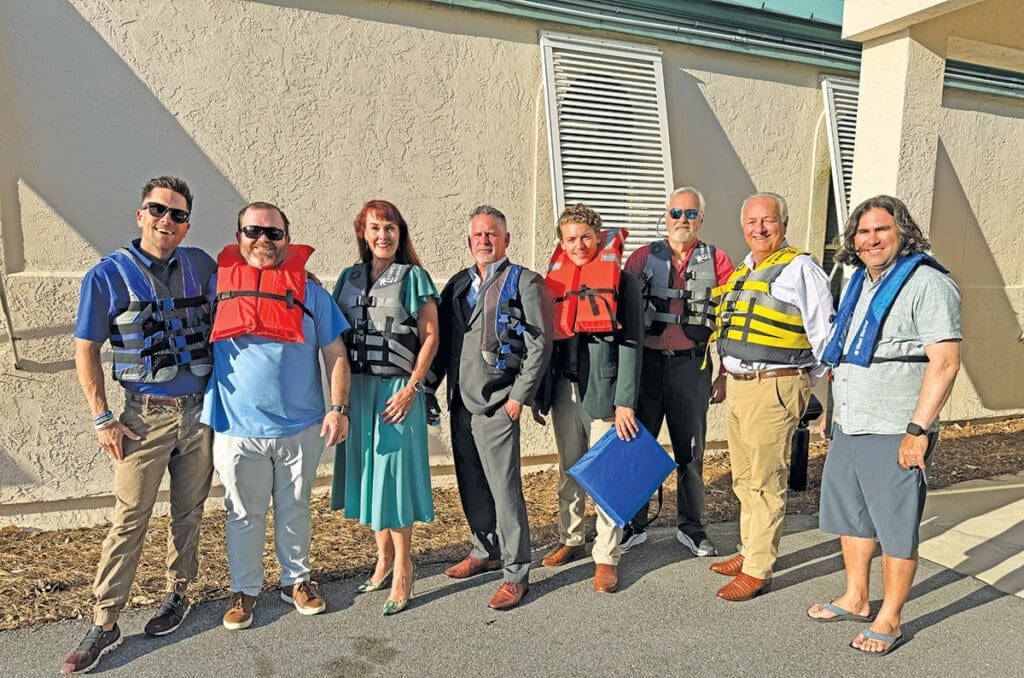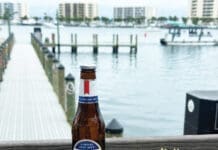By Tamara L. Young, Ph.D., Public Information Director for the World’s Luckiest Fishing Village
All 365 days out of the year, but particularly in the summer, people descend in droves from all parts of the world to Destin. Most often, they are driven by the desire to experience the emerald green waters. Many come specifically for Crab Island and, on any day of the year, you can find both visitors and locals enjoying the unique area. It’s located in national seashore waters over state-held submerged waters, and while it’s “just” a sandbar, it’s also an oasis to many and a hotbed for boaters to gather.
 Crab Island and the surrounding waters around the County offer people a chance to relax, unwind and be carefree. But carefree comes at a preventative and strategic manpower cost. For those behind the scenes, it’s a 365-day effort to keep people safe, and it takes numerous entities working in partnership to do so.
Crab Island and the surrounding waters around the County offer people a chance to relax, unwind and be carefree. But carefree comes at a preventative and strategic manpower cost. For those behind the scenes, it’s a 365-day effort to keep people safe, and it takes numerous entities working in partnership to do so.
Groups including the City of Destin, Okaloosa County Watersport Operators Coalition, Okaloosa County Coastal Resource, United States Coast Guard (USCG), Florida Fish & Wildlife Conservation Commission (FWC), Okaloosa County Sheriff’s Office (OSCO), Destin Fire Control District, Eglin AFB Marine Unit, National Parks Service, Destin Charter Boat Association, Choctawhatchee Basin Alliance and more – several more – work together.
Trainings & Wristbands
Kyle Corbitt with the Beach/Marine/Dive Team Special Operations of the Okaloosa County Sheriff’s Office, said, “One of the biggest things is the partnership with Watersport Operators Coalition. They have spearheaded the wristband system and the need for more boating education.”
Anyone renting vessels with the intent to drive must undergo state-mandated training, is required to watch the Okaloosa County boating and waterway safety video, receives personal watercraft or pontoon equipment training, and receives emergency contact information.
To ensure approved drivers are easily identified, they sport color-coded livery wristbands showing they’ve passed all the necessary tests and training. These wristbands easily indicate driving and license status aboard the vessel: green wristbands indicate an approved driver; pink wristbands indicate a driver with a Boater’s license; orange wristbands indicate an approved driver with a parent on board; and red wristbands indicate the individual is not approved and cannot drive the vessel.
All law enforcement on the water are keenly aware and recognize the color-coded system.
Another piece to the safety puzzle is how livery owners are doing their part in helping control boat driver alcohol consumption. “They have spotters out there”, said Corbitt, “and they have in their contracts, hey here’s your wristband, and if you’re an approved skipper and you’re caught drinking out at Crab Island, it’s a problem for us. It’s a huge liability factor, and they don’t want their insurance to increase. Safety is the biggest factor, but they have a financial interest, too.”
The partnerships appear to be working. Corbit said even though vessel stops increased last year, BUIs were down.
In 2021, there were 83 BUIs. In 2022, there were 88 BUIs. Last year, there were 18-20.
And it’s not just a decrease in alcohol-related citations. “We’ve seen an overall decrease in violations on the water with no-wake zones, lanyards on jet skis and proper life jacket usage,” said Corbitt.
Technological Innovations
GPS technology has offered one of the greatest steps forward toward safer waterways. A livery operator now has the ability to know instantaneously and specifically where all customers are at all times.
If weather patterns change or start to look ominous, livery operators have access to see which customers are in the path of danger or at greater distances away from coming back to the dock. A phone call or text to the customer ensures they have information relayed to them quickly.
Geofencing is another option for livery operators and boat drivers to maintain safety. If a customer goes out of bounds, such as going into the Gulf of Mexico, the livery operator will get a notification on their phone about it. The capability also exists to install a physical alarm on a vessel so that the boat driver is immediately warned.
Similarly, alarms can be set for maximum speed alerts. If a customer is speeding in a zone, the operator will get a notification and an alarm on the vessel will go off.
“I’ve had law enforcement tell me stories of hearing the alarm in the distance and then going to pull over the customer to make sure everyone stays safe,” said John Stephens, owner of Luther’s Pontoon, Waverunners, & Kayaks Rentals. “It’s neat to see on the app that about 75% of the customers slow down after the first alarm.”
While only a few livery owners are taking advantage of the GPS safety alarms, it’s only a matter of time before others jump on board.
“It helps with location, speed, and we can use it to send a jet ski spotter out there to stop some one or help them realize they’re in an area that could pose extra dangers,” said Stephens.
The waterway can appear serene but have currents and shifting patterns some don’t realize.
“If you drive a car in the U.S.” explained Corbitt, “then you go over to England and you’re not driving on the right side of the road anymore, you have to learn new rules. Much like that, boating around Destin isn’t the same as boating on Lake Michigan. You have to learn the rules of the road where you’re at.”
Long-time locals are not immune. The County changes wake zones, so it’s recommended to pay attention to the City social media and other platforms.
Locals are often looked at to set the example. “Others are watching what you do, so we want locals setting the stage for safety,” said Corbitt. “Visitors will follow what they see charter captains and parasailing folks doing and where they are going.”
Aqua Alert
While looking serene, “The currents around Crab Island aren’t something to mess with,” said Corbitt.
He’s been part of the beach marine unit for about seven years, and he noted the high success rate when it comes to search and rescues.
“We all communicate so well, whether it’s the FWC Coast Guard, livery vessels or spotters watching on a bad outgoing tide day. Everyone is out there and has safety in mind.”
Conceived by an idea from Judy Schink after her husband disappeared while kayaking in the Gulf of Mexico, the Aqua Alert system is a public alert notification system for missing endangered boaters or paddle craft operators. Partners in the area hope the system eventually becomes a statewide initiative and then makes it to the national level. Currently, locals or visitors need to have the Okaloosa County Sheriff’s Office mobile app to receive notifications.
“Not all locals or tourists coming to town for a few days will have the app,” said Corbitt. “We’d like it to be like an Amber Alert. If you have a missing 3-year-old in Miami, you’re going to get a description of the car and other details. You never know who might be around to see something and report in from the water.”
From education to advocacy to technology, Destin prides itself on its partnerships and being a model for boating safety. The 365-day water work week never stops.





























































